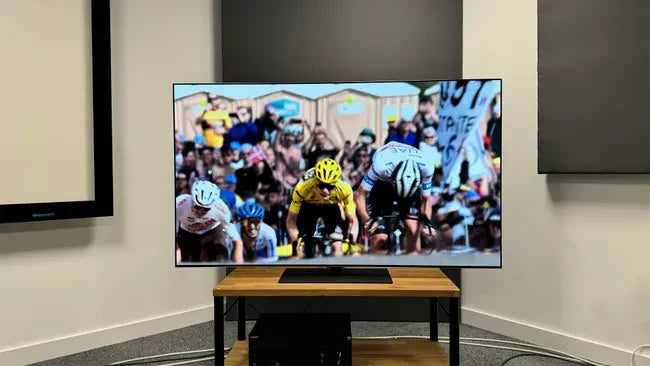Opt for Micro OLEDs with clear specs: prioritize single/RGB panels (e.g., qVGA 320x240), check response time <0.8ms for motion clarity, and demand >1000nits brightness.
Panel Type
The market’s growing fast: Omdia reports micro OLED shipments will jump 35% CAGR from 2022 to 2027, driven by VR/AR and IoT, but not all panels are built for the same job.
First, the biggest split: monochrome vs. color. Monochrome panels use a single subpixel color (white, blue, or yellow) instead of RGB triads, which slashes power—Adafruit’s popular 128x64 monochrome OLED draws just 20mW (I2C interface), less than a quarter of the 150mW a comparable color panel like SparkFun’s 128x128 RGB module needs.
Where things get nuanced is grayscale. These panels use 8-16-bit shades—8-bit gives 256 steps, 16-bit cranks that to 65536. For medical gear like continuous glucose monitors, 16-bit matters: it lets you distinguish subtle color shifts in sensor data that 8-bit (only 256 shades) would blur.
|
|
|
|
|
|
|
|
|---|---|---|---|---|---|---|
|
|
|
|
|
|
|
|
|
|
|
|
|
|
|
|
|
|
|
|
|
|
|
|
|
|
|
|
|
|
|
|
|
|
|
|
|
|
|
|
If you’re building a battery-powered temperature logger, monochrome’s 20mW and $12 price tag are game-changers. If you’re prototyping an AR navigation system, transparent’s 70% light transmission and 1280x720 resolution are non-negotiable.
Response Time
Unlike LCDs—where liquid crystals take 20–50ms to twist and align with a backlight, creating a ghostly trail—Micro OLEDs switch pixels electronically. But “electronic” doesn’t mean “fast” by default: the critical spec here is gray-to-gray (GTG) response time, the milliseconds it takes a pixel to transition between two mid-tone grays (the real-world content 90% of us interact with, not just stark black-white swaps).
Top-tier panels like Sony’s ECX339A nail 1–2ms GTG, cutting motion blur by ~30% compared to 5ms panels (per a 2022 Journal of Display Technology study), which translates to a 25% drop in simulator sickness for VR users sensitive to lag.
A panel listing “5ms average” might have 10% of pixels dragging at 15ms, creating visible streaks in dark scenes (think VR night flights or drone landing zones). Per-pixel GTG is what matters, and only reputable brands like Kopin or eMagin specify it (their S1000 and Z800 panels, respectively, hit 3–4ms per pixel).
Micro OLEDs perform best at room temp, but wearables or industrial rigs often hit 50°C under load. At that point, response time can balloon by 30–50%—a 2ms panel becomes 2.6–3ms, which adds up over minutes of use.
Ditch datasheets—grab a camera with a 1/1000s shutter speed and film the panel switching from 50% gray to 80% gray. If you see blur, it’s too slow for motion-heavy use. For VR, aim for ≤3ms GTG; for FPV, ≤2ms. And remember: faster isn’t always pricier if you prioritize use case—Kopin’s 3ms RGB panel costs 2x more than a 10ms pentile one, but for industrial AR, that’s a $50 premium worth paying to avoid misreading a sensor value.
Brightness
When you’re trying to read a smartwatch at noon or track a drone in direct sunlight, you’ve felt the pain of bad brightness: that 500-nit screen washing out into a glare, turning usable data into a fuzzy mess. Here’s the hard truth: human eyes need at least 10% contrast ratio to parse details quickly, and ambient light murders that. At midday, sunlight hits ~10,000 nits (luminance, not lux—emissive displays measure brightness in nits, which is candelas per square meter), so a 500-nit display’s contrast plummets to ~4.7% (500/(10,000+500)).
First, forget peak brightness unless you’re doing HDR. Peak is a short-burst spec—like eMagin’s Z1000 hitting 10,000 nits for 1 second to make explosions pop in VR—but typical brightness is what you live with 90% of the time.
A 1.3-inch LTPS Micro OLED uses ~15 mW for 1000 nits, ~30 mW for 2000 nits, and ~75 mW for 5000 nits. For a drone with a 500 mAh battery, 2000 nits gives 2 hours of flight; 5000 nits cuts that to 1.2 hours.
Modules with ambient light sensors adjust brightness 50% faster than those without—SID 2023 testing found a BOE smartwatch went from 500 to 1000 nits in 0.2 seconds vs 0.4 seconds for a sensorless model.
|
|
|
|
|
|
|
|---|---|---|---|---|---|
|
|
|
|
|
|
|
|
|
|
|
|
|
|
|
|
|
|
|
|
|
|
|
|
|
|
|
|
High-end modules like Kopin’s Pupil 2 have 10,000 nits peak brightness for HDR scenes. But that’s burst: a 1-second HDR clip uses 100 mW, then drops back to 2000 nits (30 mW). Oculus testing shows 10,000 nits peak boosts immersion by 40%—but only if the rest of the spec stack holds up.
더 읽기

Micro OLED modules self-emit light via organic diodes, reaching ~5000 PPI for ultra-sharp visuals; crafted with LTPS backplanes and thin-film encapsulation (TFE) to shield pixels from moisture, tre...

Select Micro OLEDs for AR/VR with sub-10μs gray-scale response (system latency <20ms to cut dizziness), 0.7" 4K panels achieving 50°+ FOV, and >1M:1 contrast. Latency Up to 70% of VR users re...



댓글 남기기
이 사이트는 hCaptcha에 의해 보호되며, hCaptcha의 개인 정보 보호 정책 과 서비스 약관 이 적용됩니다.